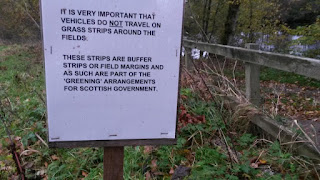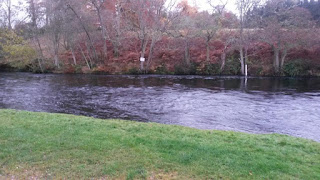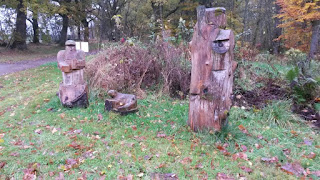THE AA BRA NEST
For an early November walk, the Dinosaurs visited Brahan Estate and Dunglass Island.
We were unable to attend due to a doomed attempt to recapture our lost youth at a 40 year College Reunion. Nonetheless, I feel confident that I can accurately reflect what happened on the walk on the basis of the wonderfully descriptive photos sent to me by Mac.
Actually, this might be more difficult than imagined. Mac tells me this is a photo of Jimmy looking at something unknown. I suspect it is a more a call of nature that is being answered, but it is a bit hard to tell from this viewpoint.
Apparently it was a bit wet at the start of the walk.
These look suspiciously like vehicle tracks that have caused the puddles to form.
If so, that would be very naughty because....
....there is a sign saying they should not do that. I know vehicles cannot read, but most owners should be able to, although we are a bit out in the sticks here.
Field margins are important habitat for wild birds and small mammals and their preservation is often vital to their survival. They provide corridors for wildlife to move along and between fields that are otherwise monocultures of whatever the farmer has planted, fertilised and generally sprayed with chemicals or manure high in nitrates.
So remember, buffer strips are nothing to do with aged aristocrats taking their clothes of in open air.
A bridge photo. As you can see Mac has just as much trouble as I do in getting everyone to look at the camera. I can understand Dave and Janet being distracted by the dog, which is called Lola. Who wouldn't be distracted by a blonde called Lola who just seems to want to lick your fingers?
Sandra, on the other hand, has no such excuse!
Now that they are paying attention they are doubtless looking for a bit of information.
They are on the bridge across the Conon River to Dunglass Island. This island is about 99 acres in extent and, so, is actually one of the largest freshwater islands in Scotland!
It also contains the site of an Iron Age fort, which might have been called a Dun. Dunglass could translate from the Gaelic as green hill or dun.
The Conon is said to have been the home of a water horse or Kelpie.
Lola begs in vain for a titbit from Janet, while her owner (Lola's, that is) looks on amazed that someone could be so hard-hearted as to deny a poor dog a bone. Perhaps that was because she had read Maureen's book about the true stories behind nursery rhymes.
Old Mother Hubbard was thought to be about Henry VIII and his attempt to get a divorce from his first wife. He sent Old Mother Hubbard (Cardinal Wolsey) to the cupboard (the Vatican) to get a bone (Divorce scroll) for her dog (Henry VIII). Of course, he didn't get a divorce and eventually he had to resort to other, more drastic means to separate himself from his many wives.
Mac says they were admiring the weir here, but I thought that was Jimmy in the first photo.
Indeed, so full had been his bladder, that the path they were to take had been flooded.
Robin and Dave looked on from the levee admiringly at such a flow of water.
At least, they told Mac that is what they were standing on, despite the complete absence of any Chevy that might have transported them there.
Of course, Don Mclean's song was all about lost innocence, something I feel that these two will have forgotten about some time ago.
Lunch at a fishing hut.
You would think that the people using the hut would be hoping for a salmon or two, but the Conon is also known for a population of lampreys. Lampreys are older than the dinosaurs, even Dave, having evolved 200 million years before them.
This brings us back in a roundabout way to Henry VIII as one of his predecessors as King, Henry I died after eating a surfeit of lampreys. Despite this a lamprey pie is traditionally delivered from Gloucester to the monarch at their coronation. This is because King John fined the city about £250000 in today's money for failing to provide him with a pie for Christmas.
Lampreys are an indicator of very clean water and they have only recently returned to many British rivers as pollution has reduced. The Lampreys in the pie given to the Queen for her Diamond Jubilee were imported from Canada.
A sign on the other side of the river. This reads "RSPB not welcome here either".
The sign is on the Conon Estate, which is owned by John MacKenzie, who also owns Gairloch Estate. He feels that RSPB have started a vendetta against landowners, farmers and crofters in Scotland. His view is that the organisation treats these land users with suspicion and follows on from the way in which Red Kite nests on his estate were being monitored.
As it happens John was, and may still be, a depute Lord Lieutenant and I know him. He is a larger than life laird and likes to speak his mind. Some would say he is a breath of fresh air.
This would be a run of river hydro scheme. I did have a quick look for more details about this, but have failed to find anything.
This looks like Jimmy, or worse, but I hope it is a sculpture of a fisherman.
More wooden sculptures.
Mac, the statistician, tells me that the walk started in Conon Bridge opposite the church and was 7.2 miles in total; 1.4 miles to the island and 1.7 miles round it. Lunch on island at 2.7 miles then continuous light rain. Mrs Pollock estimated 7.99 miles from her pedometer but her feet are so small that this can be discounted. She was invited to re-calibrate her feet! I would be quite keen to see that.
Thanks to Mac and Janet for arranging the walk and also to Mac for the photos. I hope I have done them justice.















0 Comments:
Post a Comment
<< Home